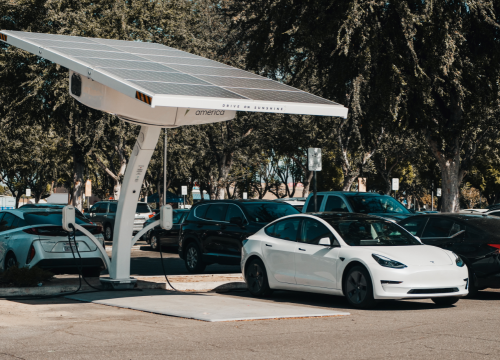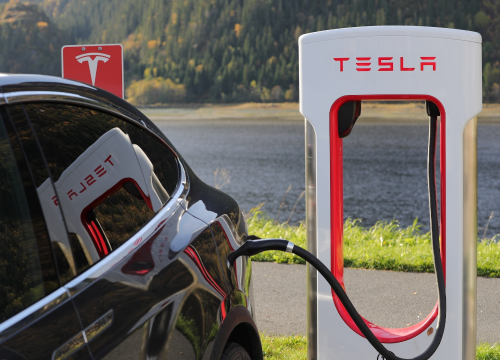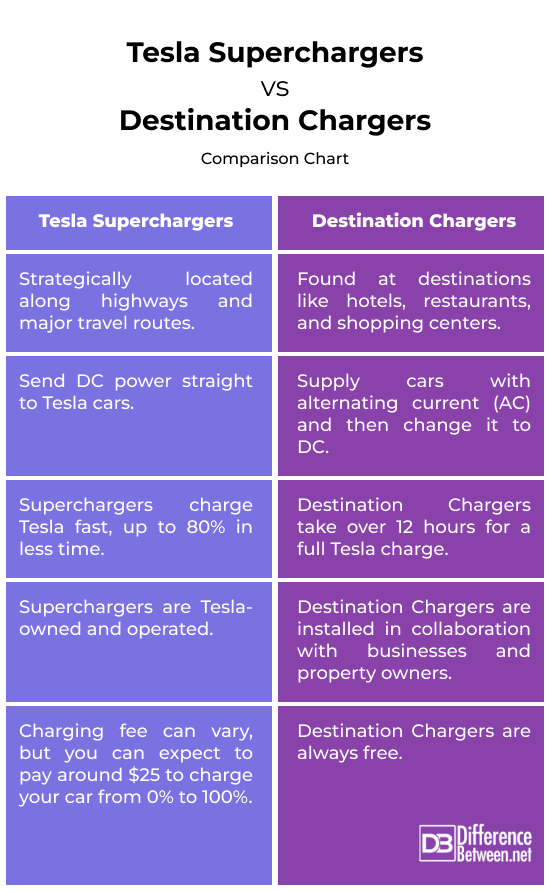Difference Between Tesla Supercharger and Destination Charger
When it comes to electric cars, one of the major concerns for customers is charging. The fear of running out of battery during a long road trip is a genuine worry. If you’re a Tesla owner, you’ve probably found yourself weighing the options: Supercharger or Destination Charger? Let’s dive into the differences between Tesla Superchargers and Tesla Destination Chargers to find out which one suits your charging needs best.

What is a Tesla Supercharger?
Tesla Superchargers are DC-powered fast-charging stations designed specifically for Tesla electric vehicles (EVs). These stations are strategically located along highways and in urban areas to facilitate long-distance travel and provide a quick charging option for Tesla owners. The first Tesla Supercharger station was officially unveiled and opened to the public in September 2012, as the Model S went into production. As of September 2023, Tesla has over 5,500 Supercharger stations throughout Asia Pacific, Europe, and North America.
Tesla vehicles are equipped with a navigation system that suggests Supercharger stops along the way. These are usually associated with a payment system linked to the user’s Tesla account. The cost of charging is based on factors like the region and charging speed.

What is a Tesla Destination Charger?
Destination chargers are a part of Tesla’s charging infrastructure, but unlike Superchargers, these are installed at various destinations such as hotels, restaurants, shopping centers, and parking facilities. These chargers provide Tesla owners with a convenient charging solution while they are parked at a destination for an extended period of time. You can use the Tesla app to find and check the availability of nearby parking spaces.
Unlike the speedy Superchargers meant for road trips, Destination Chargers provide a more relaxed charging speed, offering a chill spot for your Tesla to refuel while you do your thing. These are often located in areas with amenities such as hotels or restaurants. This allows Tesla owners to make the most of their time while their vehicles charge.
Difference between Tesla Superchargers and Destination Chargers
Location
Superchargers are strategically located along highways and major travel routes, offering high-speed charging to get you back on the road quickly. These are primarily geared for long-distance travel. Destination Chargers are mainly installed at destinations like hotels, restaurants, shopping centers, and parking facilities. These chargers are mainly designed for road trips, providing a more relaxed charging speed while you do your thing.
Charging Speed
Superchargers deliver a high charging capacity, allowing Tesla vehicles to gain a significant amount of range in a short period of time. Superchargers charge Tesla fast, up to 80% in less time, using strong 450-volt power. Supercharger stations are typically busy, especially during the winter, so you may have to wait for a while. Destination Chargers offer a slower charging speed, making them suitable for longer stays like overnight parking. These take over 12 hours for a full Tesla charge.
Installation Partnerships
Superchargers are Tesla-owned and operated. They are strategically placed to facilitate efficient long-distance travel, often near amenities like restrooms and restaurants. Destination Chargers, on the other hand, are located in areas with amenities such as hotels or restaurants. These are installed in collaboration with businesses and property owners to benefit both Tesla owners and the hosting establishments.
Compatibility
Superchargers are exclusively designed for Tesla vehicles and use a proprietary connector for faster charging. Destination Chargers, on the contrary, are designed for Tesla vehicles but often equipped with a standard J1772 connector, which allows other electric vehicles to use them, albeit at a slower charging rate. Additionally, Destination chargers give your electric car AC power and then change it to DC. Superchargers skip the wait and send DC power straight to your Tesla.
Tesla Superchargers vs. Destination Chargers: Comparison Chart

Summary
Destination Chargers provide a more convenient charging option for Tesla owners while they are at destinations for an extended period. These chargers contribute to the overall accessibility and usability of electric vehicles in everyday scenarios beyond long-distance travel. Superchargers are strategically located along highways and major travel routes, offering high-speed charging to get you back on the road quickly.
FAQs
Can anyone use a Tesla destination charger?
Yes, anyone can use a Tesla Destination Charger. While they are designed for Tesla vehicles, they often come with a standard J1772 connector, allowing other electric vehicles to use them.
How fast are Tesla destination chargers?
Tesla Destination Chargers typically provide a slower charging speed. The exact speed can vary, but they are designed for longer stays, like overnight, where the vehicle can be plugged in for an extended period.
Do Tesla destination chargers have idle fees?
Generally, Tesla Destination Chargers do not have idle fees. Unlike some Superchargers, there is usually no fee for leaving your vehicle plugged in at a Destination Charger after it’s done charging.
Which is a better charger for Tesla?
If you’re on a road trip or need a quick charge, Superchargers are designed for speed. If you’re staying at a destination for a while, like a hotel, a Destination Charger is more convenient.
Are Tesla destination chargers always free?
Yes, in most cases, Tesla Destination Chargers are free to use.
Can you charge a non-Tesla at a Tesla destination charger?
Yes, you can charge a non-Tesla electric vehicle at a Tesla Destination Charger if it has a standard J1772 connector. However, keep in mind that the charging speed may be slower for non-Tesla vehicles.
- Difference Between Caucus and Primary - June 18, 2024
- Difference Between PPO and POS - May 30, 2024
- Difference Between RFID and NFC - May 28, 2024
Search DifferenceBetween.net :
Leave a Response
References :
[0]Zhang, Michael W. Strategic Management and Sustainability Transitions: Theory and Practice. Taylor & Francis, 2023.
[1]Hamilton, Sue L. Tesla. Abdo Publishing, 2022.
[2]Rapier, Graham. “Tesla destination charger guide: What to know about the network, how it compares to superchargers.” Business Insider, 12 July 2023, www.businessinsider.com/tesla-destination-charger?IR=T.
[3]Image credit: https://www.canva.com/photos/MADQ4_j6rpM/
[4]Image credit: https://www.canva.com/photos/MAEr-1gbuJc/
